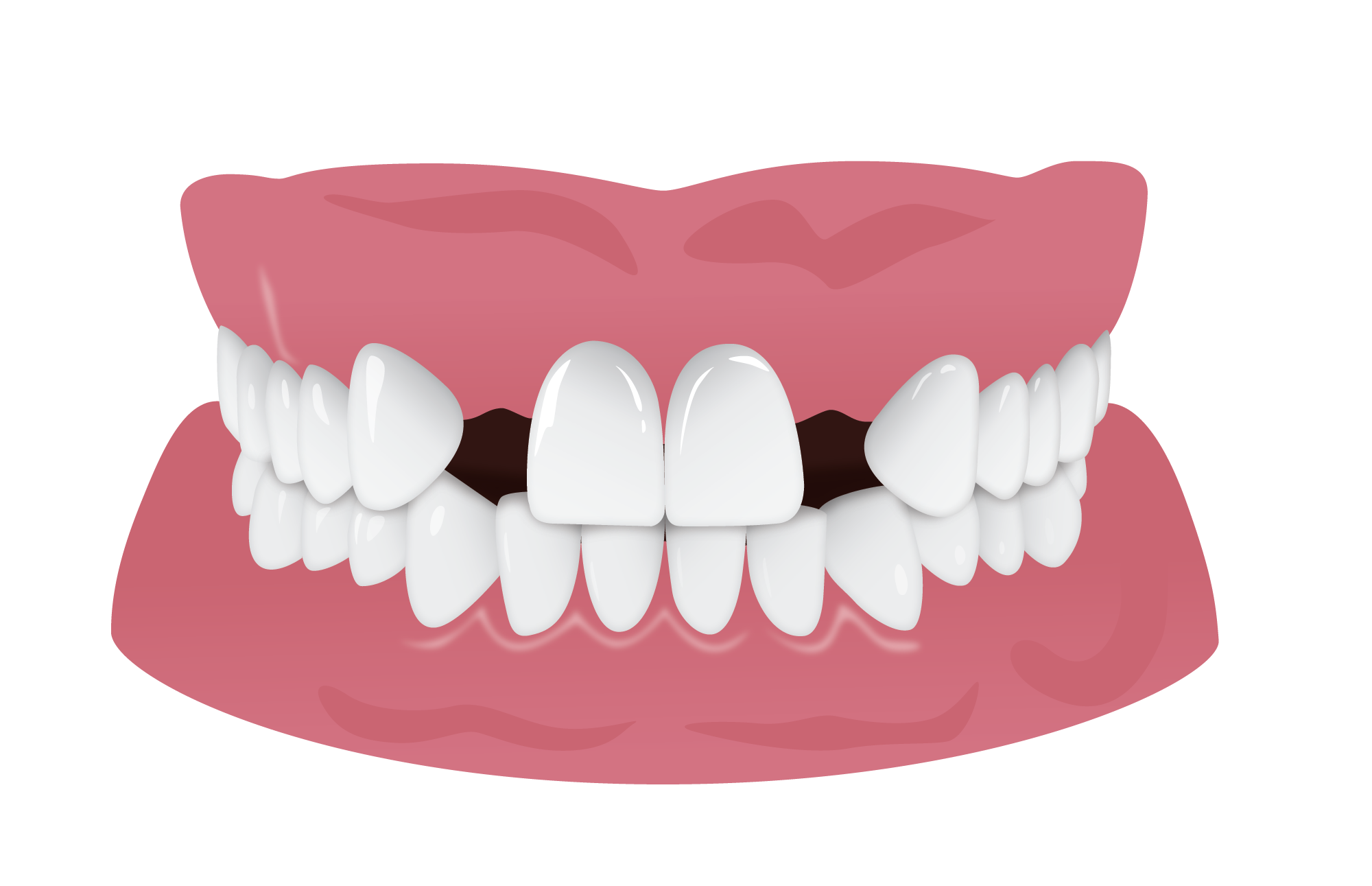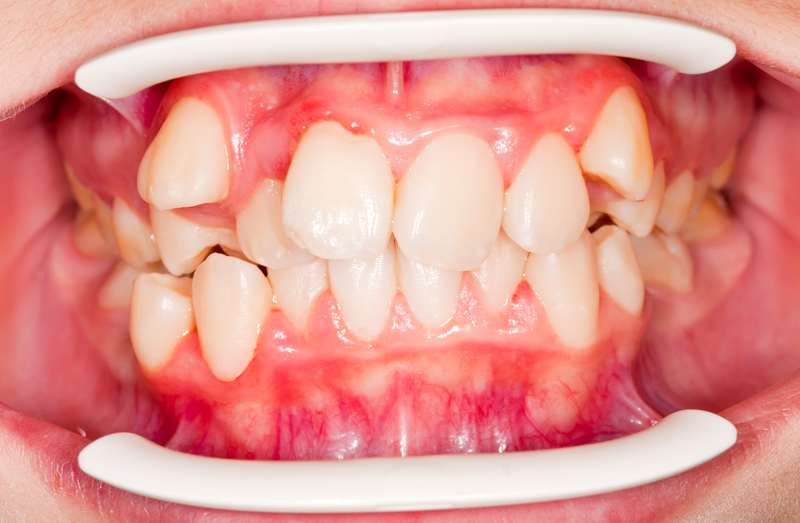Have you ever wondered if you have some orthodontic challenges with your teeth? If you have, try not to worry too much. The majority of people aren’t born with perfect teeth. But to help put your mind at ease (or confirm your suspicions), here’s a list of the top 10 most common orthodontic problems, including the medical explanation as well as causes & treatments!
1. Crowding
The medical explanation of Crowding
ALD or Arch Length Discrepancy, which is displacement of opposing teeth.
The simple explanation of Crowding
When teeth are pushed together causing them to overlap each other or when there is not enough space in the jaw and teeth grow out twisted to fit into space.
What causes Crowding?
Crowding can be caused by early tooth loss of the baby teeth and the jaw has not grown enough to support the adult teeth coming through and it’s one of the most common orthodontic problems. Another reason can be that the teeth shape can be too large for the jaw size or too many teeth have erupted at once.

What are the symptoms of Crowding?
Symptoms can be varied. For example, hard to floss in between teeth cause gingivitis or create difficulty brushing teeth. Another example is uneven tooth wear due to teeth not aligning properly when chewing. Additionally, chewing can be difficult or the speech can be affected.
How is Crowding fixed?
Crowding can be rectified by expanding the jaw or arch of the teeth by using braces or in some cases the orthodontist will suggest an expansion appliance as well as braces.
2. Overjet
The medical explanation of Overjet
Overjet is the protrusion of teeth that sit much further forward than the bottom teeth. Either the maxillary anteriors are proclined or the mandibular anteriors are retroclined. The overjet distance is vertically measured by the orthodontist.
The simple explanation of Overjet
Overjet is when the front upper teeth point outwards from the lips, sitting much further forward than the bottom teeth.

What are the causes of Overjet?
Can be caused by skeletal formation, thumb sucking habit, or where and how the upper and lower jaw sits in reference to each other.
What are the symptoms of Overjet?
Teeth not sitting together in the right proportion when mouth is closed or biting down can be the general symptom.
How is Overjet fixed?
A common solution is to use braces and elastics to bring back the upper teeth.
3. Spacing
The medical explanation of Spacing
Space between the two front upper teeth is called a diastema.
The simple explanation of Spacing
Gaps or spacing between one tooth or multiple teeth throughout the mouth, meaning the teeth do not touch each other.

What are the causes of Spacing?
There can be a number of factors that contribute to spacing between the teeth, smaller than average sized teeth, teeth that have been pushed out by thumb sucking and gum disease. Other causes can be genetic such as diastema, which is excess skin causing spacing between front upper teeth or tongue thrust action from an enlarged tongue.
What are the symptoms of Spacing?
Symptoms are general with visibly noticeable gaps between teeth.
How is Spacing fixed?
Orthodontic treatment or building up the teeth with veneers or bonding the teeth.
4. Crossbite
The medical explanation of Crossbite
Crossbite is a form of malocclusion.

The simple explanation of Crossbite
Crossbite is the misalignment of upper and lower teeth when biting together. This is when a tooth or a number of teeth are either closer to the cheek or to the tongue in one jaw and the other teeth are in the opposite direction. This means when biting down the teeth do not come together correctly.
What are the causes of Crossibite?
In some cases the upper and lower jaw can be either smaller or larger than the referring jaw. In other cases it can be just a couple of teeth that have been pushed out due to teeth crowding, trauma or thumb sucking.
What are the symptoms of Crossbite?
Teeth not fitting well together in relation to each other when chewing can cause wearing of the enamel and tooth, can also cause pain in tooth if left long enough as it places undue pressure on different areas of the tooth.
How is Crossbite fixed?
There are a number of ways to correct crossbite, one option is the use of expansion plates which expand the adjacent jaw and then introduce elastics with brace wear.
5. Openbite
The medical explanation of Openbite
Types of openbite; Anterior, Posterior, Skeletal and Dental. These are a type of malocclusion.
The simple explanation of Openbite
Malocclusion is the misalignment of teeth and it’s also one of the most common orthodontic problems. Openbite is one type of Malocclusion; there are a number of different types of Malocclusions. Openbite is when the teeth are biting down together and the back upper and lower teeth touch and the front upper and lower teeth do not touch and have an obvious visible gab between upper and lower teeth.
What are the causes of Openbite?
There are a few different causes; starting with abnormal bone and jaw growth or a large tongue causing tongue thrust motion, a repeated motion of pushing the tongue forward when swallowing causing continual pressure on front teeth eventually resulting in them moving forward.

What are the symptoms of Openbite?
In severe cases people have trouble eating, chewing and biting down. Speech can also be affected. Openbite can cause abnormal jaw growth creating abnormal tongue habits eventually developing into tongue trust habit.
How is Openbite fixed?
Orthodontic treatment with braces, appliances and head gear devices will assist in correcting the jaw and in young children, assist in correcting the skeletal development. In severe cases surgery may also be an option.
6. Missing teeth
The medical explanation of Missing Teeth
Hypodontia, congenital missing teeth.
The simple explanation of Missing Teeth
Missing teeth is to the reference of adult teeth that are permanently absent, that may have never grown or teeth that have been removed leaving a gap in the gum.
What are the causes of Missing Teeth?
Some people are born with missing teeth, meaning that the body never produced the regular amount of teeth that a person should usually have.
Another cause of permanently missing teeth is poor oral health, tooth decay, leading to the removal of a tooth.
Or gum disease can cause tooth loss, as well as trauma caused by a fall or accident.

What are the symptoms of Missing Teeth?
Missing teeth in a person still growing can cause other teeth to merge into this open or available space as they grow causing a number of orthodontic issues, such as spacing, teeth growing out on different angles and misalignment.
The removal of adult teeth create a large gap where a tooth would normally be which can lead to other teeth “leaning” or moving into this space.
How do you fix Missing Teeth?
A gap can be filled by orthodontic movement of teeth into the gap, in some cases using a TAD (temporary anchorage device) system and braces. In some cases this movement of teeth is not possible so alternatively implants are suggested.
7. Impacted teeth
The medical explanation of Impacted Teeth
Impaction of teeth.
The simple explanation of Impacted Teeth
One of the most common orthodontic problems is having an impacted tooth, which is a tooth that is blocked from growing out fully in its allocated space.
In fact it’s one of the primary reasons why people need to have their wisdom teeth removed.
What are the causes of Impacted Teeth?
The tooth may not be able to erupt correctly if there was not enough room or tooth is growing in the wrong direction to then be blocked by another tooth or bone.

What are the symptoms of Impacted Teeth?
Some impacted teeth do not demonstrate symptoms other than the position they sit in. However there are impacted teeth that can demonstrate symptoms causing tooth pain, inflammation, jaw pain and the inability to open the mouth fully.
How are Impacted Teeth fixed?
It is advisable to intervene the growth of impacted teeth as they are developing rather than waiting for the growth to complete.
There are a few solutions in remedying impacted teeth, one being exposing the tooth from under the soft tissue and placing a bracket and chain on this exposed tooth for anchorage.
This is mostly successful in a patient who is still developing.
The other solution if the teeth are causing pain is to surgically remove them.
If the tooth is not causing pain or is not affecting the patient aesthetically or functionally, it can be left in the current position.
8. Ankylosed Teeth
The medical explanation of Ankylosed Teeth
Ankylosis is periodontal ligament dissolved from around a tooth’s root causing fusion of the dentition, dentin, pulp and cementum to the bone or palate.
The simple explanation of Ankylosed Teeth
Teeth that have gown under the gum or palate and whilst growing fused to the bone.
What are the causes of Ankylosed Teeth?
There are no specific causes of ankylosed teeth
What are the symptoms of Ankylosed Teeth?
Symptoms of ankylosis are very general, the visibility of the tooth is reduced or the tooth is completely absent in the allocated space in the jaw, or perhaps only part of a tooth has emerged from the gum.
How are Ankylosed Teeth fixed?
If intervention is early enough and the tooth is viable, luxation is recommended.
9. Too many teeth in the mouth
The medical explanation of having too many teeth
Supernumerary teeth or Hyperdontia.
The simple explanation of having too many teeth
You may not realise it but Hyperdontia teeth is one of the most common orthodontic problems where a patient has extra teeth in mouth compared to the usual number of teeth. These teeth can erupt at the same time as corresponding teeth.

What are the causes of having too many teeth?
The exact cause of Hyperdontia is unknown.
What are the symptoms of having too many teeth?
Symptoms can vary depending on how many extra teeth there are.
Generally there is not enough room for extra teeth in the jaw as they grow in front or behind the regular teeth causing difficultly eating, speaking and maintaining proper oral hygiene.
How is it fixed?
Extraction is the best method for extra teeth and orthodontic treatment to align and close any spacing created by the extra teeth.
10. Ectopic Teeth
The medical explanation of Ectopic Teeth
An Ectopic tooth is a tooth that has erupted in a malposition
The simple explanation of Ectopic Teeth
The tooth bud which is the tooth formed in the jaw before it grows visibly to full size, grown in the wrong area in the jaw.
An ectopic tooth is a tooth that has a developmental disturbance where it does not follow the usual eruption direction.

What causes Ectopic Teeth to be common orthodontic problems?
Causes can vary for this condition.
It can be due to abnormal eruption timing or the baby teeth do not fall out in a timely manner while the secondary tooth is eruption, or a narrow jaw.
What are the symptoms of Ectopic Teeth?
Some teeth can erupt in uncomfortable areas in the mouth that can interfere with general oral function and speaking.
How are Ectopic Teeth fixed?
Orthodontic treatment would be recommended with braces and additional appliances may be needed depending on the severity of the case.




![Preventing Tooth Decay While Wearing Braces [Five-Step Guide]](https://wilkinsonorthodontics.com.au/wp-content/uploads/2015/01/Untitled-design-2022-01-20T160718.712-300x150.jpg)
